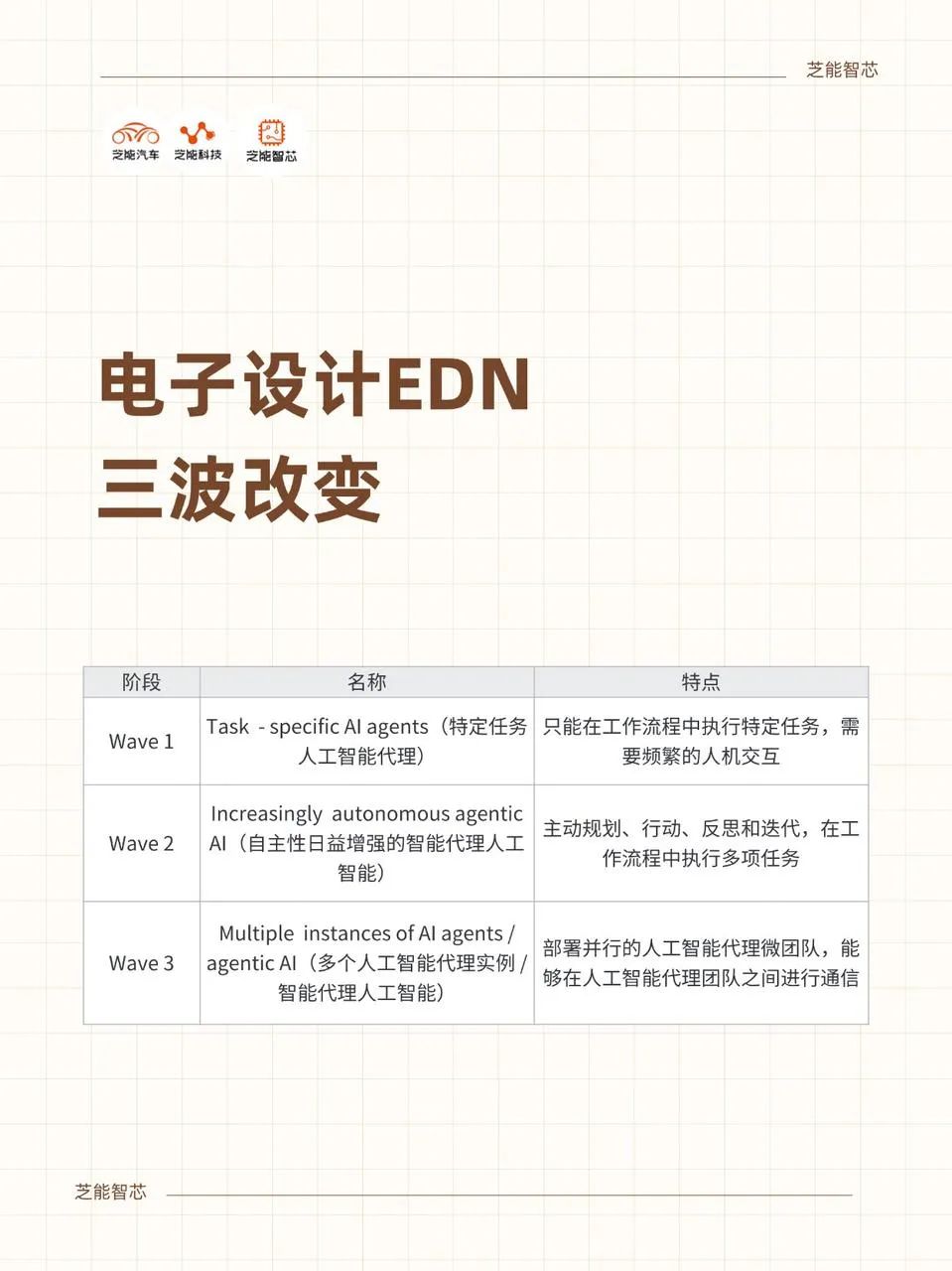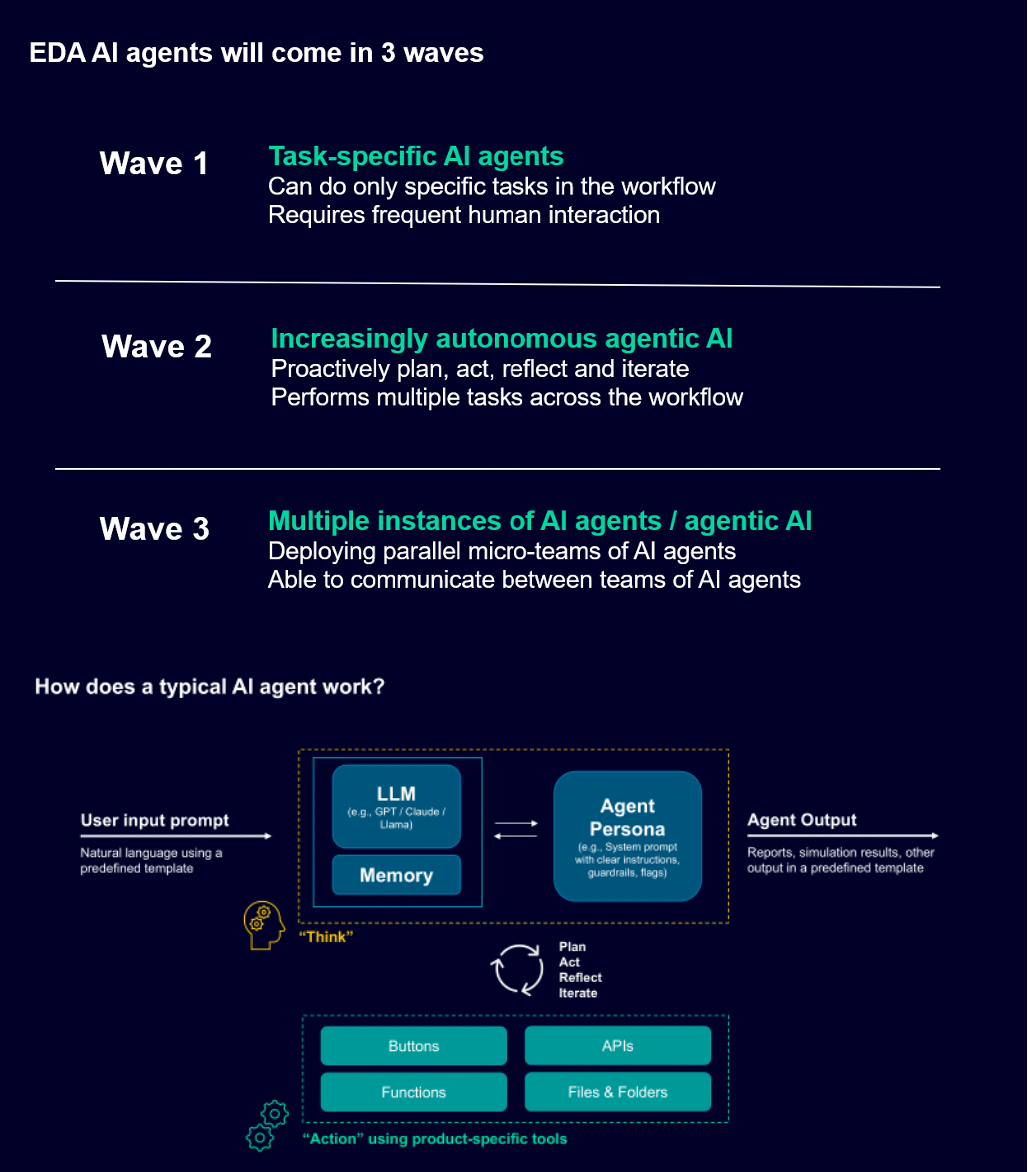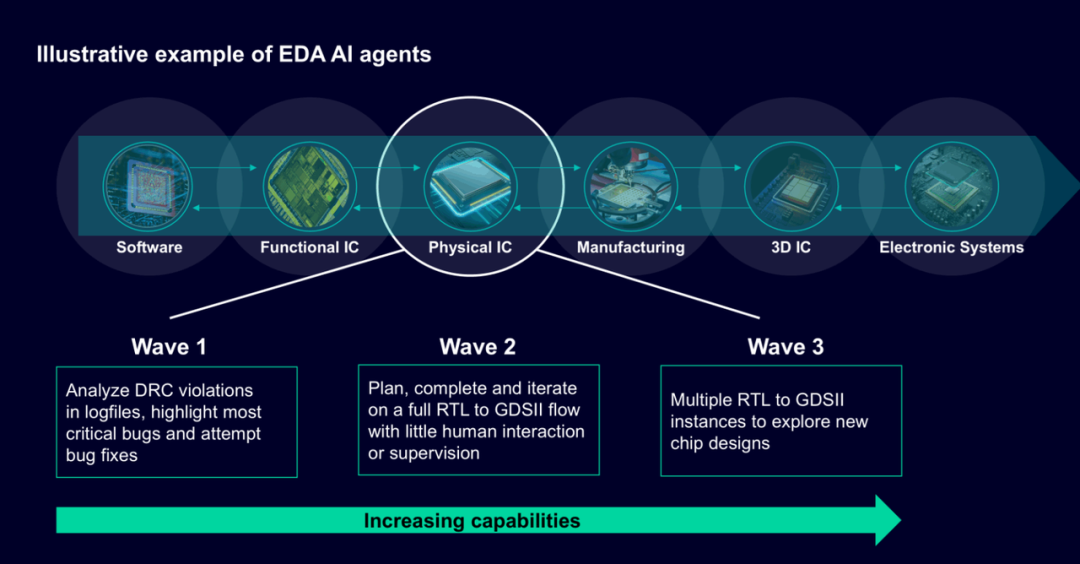Revolutionizing Electronic Design Automation (EDA) with AI Agents
![]() 05/22 2025
05/22 2025
![]() 482
482
Produced by Zhineng Zhixin
Electronic Design Automation (EDA) is embarking on a new era of intelligence. Amidst the escalating complexity of semiconductor systems and shrinking design cycles, traditional EDA workflows are struggling to keep pace with industry demands.
Artificial Intelligence (AI), particularly Agent systems with self-reasoning and collaborative capabilities, is emerging as a pivotal breakthrough to overcome efficiency bottlenecks.
From initial task-specific AI assistants to Agentic AI with autonomous planning and correction capabilities, and on to the future evolution of large-scale, multi-Agent collaboration systems, EDA is being reshaped profoundly by artificial intelligence.

Part 1
From Assistance to Initiative: The Functional Leap of AI Agents
This leap brings about transformative changes to the entire design process.
Early applications of AI in EDA primarily focused on local tasks such as accelerating simulations and optimizing routing. At this stage, AI served more as an enhanced module at the tool level.
Today, the complexity and fragmentation of the design process have driven a fundamental shift from "tools" to "Agents" in AI.
The first wave of AI Agents emerged by embedding assistants with specific capabilities into the design. These Agents can interpret natural language instructions, perform format validation, identify design rule violations, or assist in routing constraint optimization. They are deeply integrated into the EDA tool chain, utilizing large language models to semantically understand documents, standards, and scripts, thereby replacing humans in tedious processes.

At this stage, each AI Agent typically addressed a specific type of task, relying on manual supervision and coordination. This "toolset" approach to AI deployment improved design efficiency but failed to genuinely reshape the core structure of the design process. Human engineers still needed to handle high-load tasks such as task scheduling, upstream and downstream coordination, and problem tracing. The potential of AI Agents was obscured by fragmentation, and system efficiency lacked cohesion.
In the second stage, EDA AI Agents began to exhibit more "Agentic" characteristics. They were no longer mere execution bodies receiving instructions but possessed independent task decomposition, planning, execution, and feedback capabilities. The introduction of Agentic AI meant that multiple links in the EDA process no longer required frequent manual intervention.
For example, an Agent can automatically identify design errors after physical verification, adjust the layout according to the rule set, and then transmit the change information to subsequent processes, achieving an end-to-end intelligent closed loop. This type of AI not only possesses single-point reasoning capabilities but can also collaborate with other Agents to respond in tandem to design changes. This broke the previous "manual relay" method of information transfer between EDA design links, making the entire process more real-time, traceable, and collaborative. The role of EDA engineers shifted from executors to task coordinators, focusing on complex anomaly handling and strategy adjustments.
The third wave truly maximized the potential of AI Agents.
At this stage, the "AI cluster" composed of multiple independent Agents became the core skeleton of the design process. Each Agent focused on exploration tasks in different directions—some sought the lowest power consumption solutions, some optimized area utilization, and others attempted breakthrough structural designs. They operated in a parallel architecture, rapidly iterating and competing in a highly automated environment. Designers no longer needed to plan the entire structure at once but instead compared, integrated, and evolved candidate solutions provided by multiple Agents.
This "design-as-search" concept delivered exponential efficiency improvements. Architectural exploration that once took weeks could now generate multiple feasible versions concurrently in just a few hours.
Part 2
AI Agents Reconstructing the EDA Ecosystem: An Upgrade from Individual Efficiency to Organizational Collaboration

The changes brought about by AI Agents are not limited to work content and tool forms but more importantly in reshaping the roles of EDA practitioners.
In traditional processes, the value of designers was reflected in coding ability, rule memorization, and debugging experience. With AI Agents intervening in foundational work, human engineers are gradually shifting from technical execution to problem definition and strategic decision-making.
Agents can achieve round-the-clock design and continuous feedback optimization, freeing up engineers' time to focus on abstract modeling of complex problems and cross-module collaboration.
At the team collaboration level, AI Agents have broken the previous "serial" organizational structure in the EDA process.
In the past, a design task was often handed over from the frontend team to the backend, then to verification and physical implementation. Each stage was interdependent, and the more links there were, the slower the feedback. Now, with multiple AI Agents processing in parallel and providing collaborative feedback, the entire process has become more like "mesh collaboration" rather than "linear relay." Each module designer can quickly complete tasks with AI assistance and obtain real-time upstream and downstream feedback, greatly compressing iteration cycles and improving the agility of cross-team collaboration.
AI Agents have redefined the threshold for professional knowledge. Even junior designers can complete the development of complex modules with the assistance of AI Agents.
The transmission of EDA knowledge has shifted from relying on the "mentor-apprentice system" in the past to data-driven systematic knowledge injection. This is undoubtedly a significant benefit for the EDA industry, which lacks talent reserves. A more balanced distribution of talent capabilities and higher-quality project delivery will be the direct rewards of the popularization of AI Agents.
At the enterprise level, the most intuitive effect of EDA AI Agents is the shortening of design cycles and the enhancement of product innovation capabilities.
Faster design means a shorter time to market, more room for trial and error, and richer exploration of technological paths.
For chip startups, this efficiency improvement can bring the possibility of competing with large factories. For large IDMs or system vendors, it means they can take the lead in implementing technology in areas such as complex architectures and high-end packaging.
EDA is undergoing a profound transformation driven by AI, from task-specific Agents to autonomous intelligent systems, to the concurrent operation of swarm intelligence. Each wave is constantly pushing the boundaries of electronic design, enhancing design efficiency and product quality, and more critically, redefining role division, knowledge structure, and value creation methods in the design process.
Summary
Future EDA engineers will no longer be mere code movers or rule executors but design managers who cocreate and coexist with AI Agents. They will guide AI in exploring design spaces, balancing the triangular trade-off of performance, power consumption, and area, and reconstructing system architectures at a higher dimension. EDA is essentially the quintessential example of human-machine collaborative intelligent manufacturing. The full integration of AI Agents will usher in tremendous changes.





